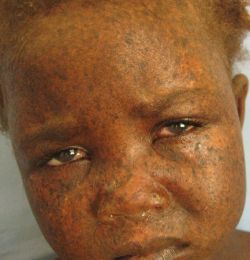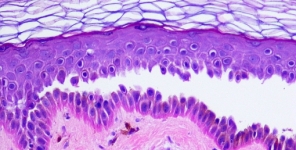Risultati extradermatologici inaspettati in 31 pazienti con xeroderma pigmentoso di tipo C
 Lo xeroderma pigmentoso di tipo C è una rara malattia autosomica recessiva caratterizzata dall'associazione di diverse manifestazioni cliniche che coinvolgono per lo più la pelle e gli occhi.
Lo xeroderma pigmentoso di tipo C è una rara malattia autosomica recessiva caratterizzata dall'associazione di diverse manifestazioni cliniche che coinvolgono per lo più la pelle e gli occhi.
Obiettivi: Valutare le manifestazioni cliniche di una coorte omogenea geneticamente caratterizzata di pazienti con XP-C.
Metodi: Sono stati contattati tutti i pazienti con XP-C confermato geneticamente o attraverso il test di Sintesi non programmata del DNA, appartenenti al registro del nostro reparto e all'associazione francese "Les Enfants de la Lune". Durante una consultazione pianificata, sono state raccolte le informazioni cliniche utilizzando un modulo standardizzato di raccolta dei dati.
Risultati: In totale, sono stati osservati 31 pazienti. L'età media alla diagnosi era di 2.95 anni; l'insorgenza dei sintomi cutanei si è verificata a 1.49 anni. Tra di loro, il 51.72% ha avuto una bassa statura relativa, con il punteggio z altezza-per-peso inferiore a -1 SD; il 59.25% ha mostrato una sindrome piramidale; e il 45.16% ha avuto fotofobia e/o congiuntivite. Quattro pazienti hanno avuto diversi granulomi piogeni. Ventiquattro pazienti (77.4%) hanno avuto il cancro della pelle. L'età media di insorgenza del primo cancro della pelle è stata di 4.76 anni (range 2-14.5). Il carcinoma basocellulare è risultato il tumore più frequente. I melanomi sono stati rari e per lo più desmoplastici. La tiroide multinodulare è stato il più frequente tumore interno.
Conclusioni: I nostri dati hanno messo in luce alcuni nuovi aspetti di XP-C. I pazienti con XPC sono a rischio di sviluppare granulomi piogeni, melanomi desmoplastici e tiroide multinodulare. Il coinvolgimento di SNC è frequente, ma il suo meccanismo non è tuttora chiaro. La statura relativamente bassa necessita di ulteriori indagini per essere spiegata. XP-C non è solo una malattia che porta facilmente al cancro, ma anche un disturbo polisistemico.
Storia della pubblicazione:
Titolo: Unexpected extradermatological findings in 31 -Xeroderma Pigmentosum type C patients
Rivista: British Journal of Dermatology. doi: 10.1111/bjd.12183
Autori: S. Hadj-Rabia, D. Oriot, N. Soufir, H. Dufresne, E. Bourrat, S. Mallet, N. Poulhalon, A. Taieb, B. Catteau, A. Sarasin, C. Bodemer
Affiliazioni: Department of Dermatology Necker-Enfants Malades Hospital and Université Paris V, Descartes, Paris, France
Centre de référence national des maladies génétiques à Expression Cutanée (MAGEC)
Department of Pediatrics, University Hospital of Poitiers, France.
Laboratoire de biochimie hormonale et génétique, Hôpital Xavier Bichat-Claude Bernard, Rue Henri Huchard 75018, Paris, France
Service de Dermatologie, Hôpital Saint Louis, 1 rue Claude Vellefaux, Paris, France
Service de Dermatologie, Hôpital Nord, 13915 Marseille, France
Service de Dermatologie Centre Hospitalier Lyon Sud 165 chemin du Grand Revoyer 69310 Pierre Benite, France
Unité de dermatologie CHU de Bordeaux Hôpital Pellegrin enfants Place Amélie Raba Léon 33076 Bordeaux cedex, France
Service de Dermatologie et de Pédiatrie CHRU de Lille — Hôpital Jeanne de Flandre Avenue Eugène Avinée 59037 Lille cedex, France
Département de biopathologieInstitut de cancérologie Gustave Roussy114 rue Edouard Vaillant94805, Villejuif, France
Abstract:
Background: Xeroderma Pigmentosum type C is a rare autosomal recessive condition characterized by the association of various clinical manifestations mostly involving skin and eye.
Objectives: to evaluate the clinical manifestations in a homogeneous genetically characterized cohort of XP-C patients.
Methods: All patients with genetically or Unscheduled DNA Synthesis confirmed XP-C from the registry of our department and the french association of patients "Les Enfants de la Lune" were contacted. During a planned consultation, clinical information was collected using a standardized Case Record Form..
Results: 31 patients were seen. The mean age at diagnosis was 2.95 years; the onset of skin symptoms occurred at 1.49 years. Among them, 51.72% had relative short stature with a height-for-weight z-score less than -1 SD; 59.25% showed a pyramidal syndrome; and 45.16% had photophobia and/or conjunctivitis. Four patients had several pyogenic granulomas. Twenty-four patients (77.4%) had skin cancer. The mean age of the onset of the first skin cancer was 4.76 years (range 2-14.5). Basal Cell Carcinoma was the most frequent cancer. Melanomas were rare and mostly desmoplastic. Multinodular thyroid was the most frequent internal tumor.
Conclusions: Our data highlights several new aspects of XP-C. XPC patients are at risk to develop pyogenic granulomas, desmoplastic melanomas and multinodular thyroid. Involvement of CNS is frequent but its mechanism remains unclear. The relative short stature needs further investigation to be explained. XP-C is not only a cancer-prone disorder but also also a polysystemic disorder





